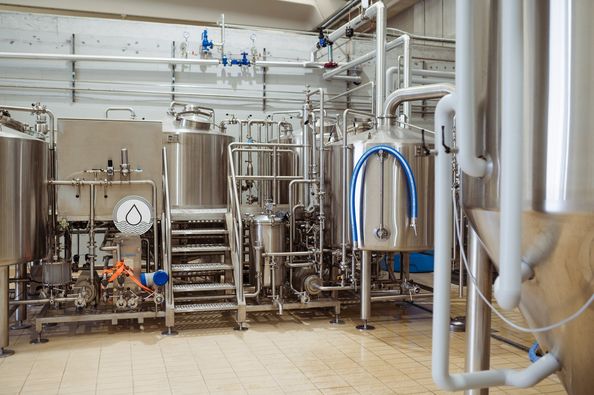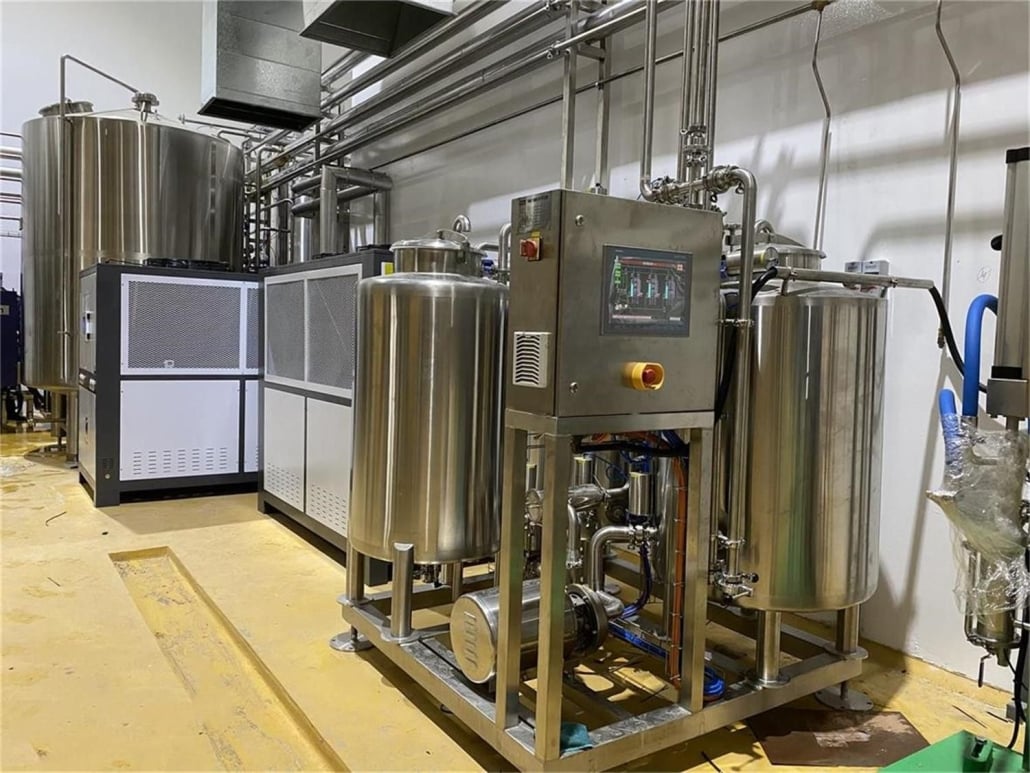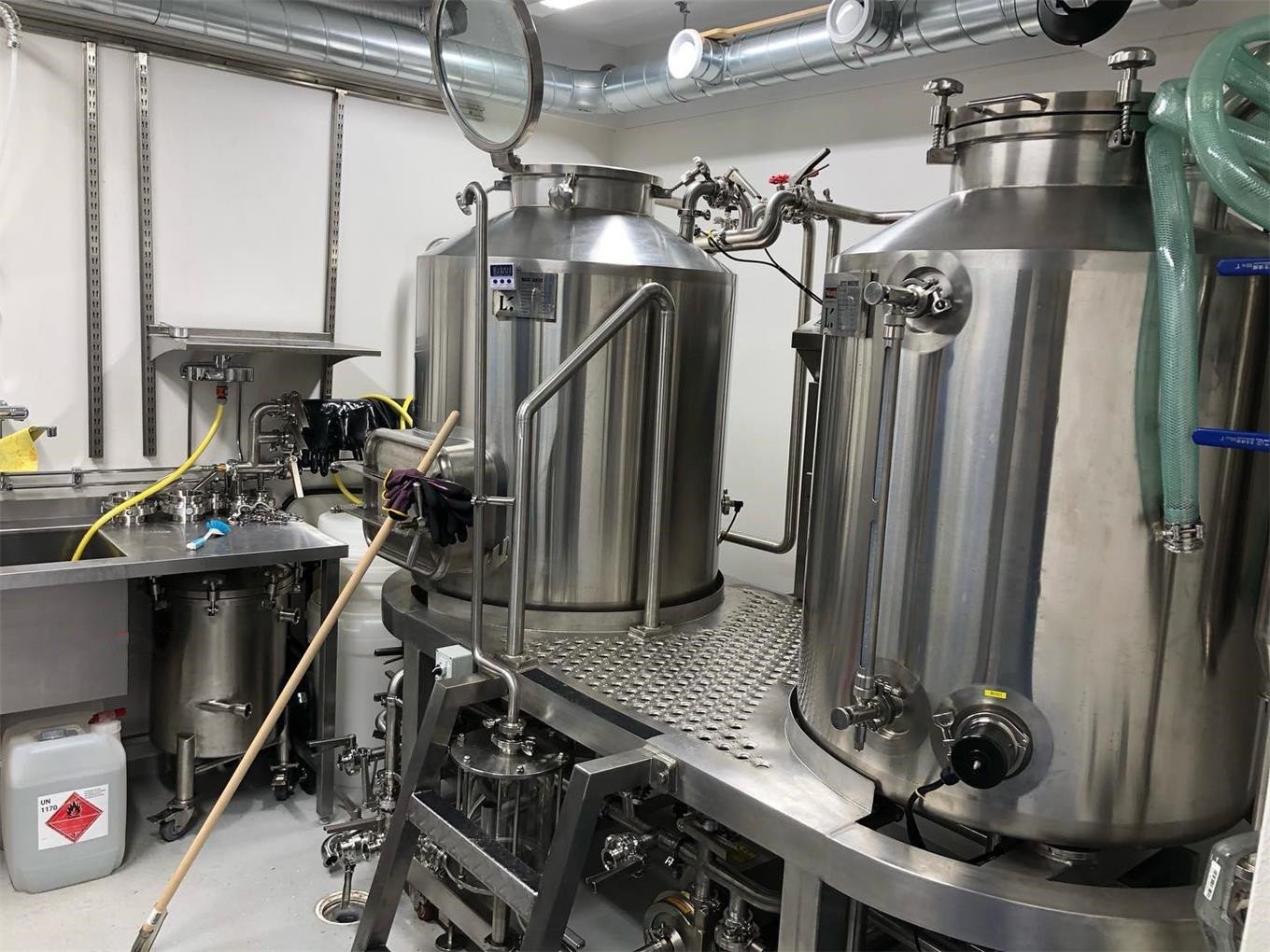Understanding Bright Brewery Tanks
Overview of Bright Brewery Tanks
When it comes to brewing, the importance of the equipment can’t be overstated. Among the essential pieces of equipment, the bright brewery tank stands out. But what exactly is a bright brewery tank, and why is it so crucial in the beer brewing process? In simple terms, a bright brewery tank is a vessel used in the beer brewing process, specifically designed to hold the beer after it has been brewed and filtered, right before packaging. These tanks are often referred to as “bright beer tanks” or “BBTs” in the industry.
The role of a bright brewery tank is vital in giving beer its final polish. It allows for the carbonation process to occur, where carbon dioxide is added to the beer, giving it that satisfying fizzy texture we all love. Without bright brewery tanks, the beer wouldn’t have that crisp, clean finish that drinkers expect.
But beyond carbonation, these tanks also serve as holding vessels where beer is stored at low temperatures, ensuring it remains fresh and stable until it’s time to be packaged into bottles, cans, or kegs. These tanks are generally made of stainless steel and can vary greatly in size depending on the scale of the brewery.

Equipment Guide: Bright Brewery Tank Essentials
If you’re setting up a brewery or upgrading your existing setup, understanding the different components and features of a bright brewery tank is key to making informed decisions. Let’s dive into the essentials.
Construction Material: Stainless Steel
Most bright brewery tanks are made of stainless steel due to its durability, resistance to corrosion, and ease of cleaning. Stainless steel also doesn’t react with the beer, ensuring that the flavor remains pure and untainted. This material is critical in maintaining the hygiene and longevity of the equipment.
Pressure Rating
Bright brewery tanks are typically designed to withstand significant pressure, which is crucial during the carbonation process. The pressure rating of a tank is a key specification, often measured in PSI (pounds per square inch). The higher the pressure rating, the more versatile the tank, allowing for a variety of beer styles and carbonation levels.
Temperature Control
Temperature control is another essential feature of bright brewery tanks. The ability to maintain a consistent, low temperature is vital for preserving the beer’s quality during storage. Many tanks are equipped with cooling jackets or glycol systems that allow precise temperature adjustments, ensuring the beer remains at the perfect temperature.
Capacity
Bright brewery tanks come in a wide range of capacities, from small tanks suitable for microbreweries to large tanks that can hold thousands of liters for larger operations. The capacity you need will depend on the scale of your production and the variety of beers you plan to brew.
Top Features to Look for in Bright Brewery Tanks
- Sight Glasses: These allow brewers to visually inspect the beer inside the tank, which is essential for monitoring clarity and cleanliness.
- CIP (Clean-In-Place) Systems: Automated cleaning systems that simplify maintenance and ensure the tank is sanitized effectively after each batch.
- Carbonation Stones: These are used to introduce CO2 into the beer, allowing for precise control over carbonation levels.
- Pressure Relief Valves: Safety features that prevent the tank from over-pressurizing, which could be dangerous and damage the equipment.
Bright Brewery Tank Types and Their Applications
Choosing the right bright brewery tank depends on your specific brewing needs. Here’s a breakdown of the most common types of bright brewery tanks and their applications.
| Tank Type | Description | Best For |
|---|---|---|
| Vertical Bright Tanks | Tall, narrow tanks that are ideal for breweries with limited floor space. | Breweries in urban areas with space constraints |
| Horizontal Bright Tanks | Wider and lower to the ground, these tanks offer greater stability and are often used in larger brewing operations. | Large-scale breweries |
| Stackable Bright Tanks | Designed to be stacked on top of one another, these tanks maximize vertical space, making them ideal for breweries with high ceilings. | Breweries looking to expand capacity vertically |
| Portable Bright Tanks | Smaller tanks equipped with wheels, allowing for easy transportation and flexibility in the brewing process. | Small breweries or pilot brewing systems |
Choosing the Right Type for Your Brewery
When selecting a bright brewery tank, consider the size of your brewery, your production goals, and the available space. For instance, if you’re operating in a compact area, vertical or stackable tanks might be your best bet. On the other hand, if you have ample space and require high stability, horizontal tanks may be more suitable.
The Brewing Process: How Bright Brewery Tanks Fit In
The brewing process is a complex journey that transforms raw ingredients into the refreshing beer we enjoy. Bright brewery tanks play a critical role in the final stages of this process. Here’s a step-by-step look at how these tanks are utilized.
1. Fermentation Completion
After the beer has undergone primary fermentation, it is transferred from the fermenter to the bright tank. At this stage, the beer is technically “finished,” but it needs some refinement before it’s ready for packaging.
2. Carbonation
Once in the bright tank, carbonation is introduced. This is typically done using a carbonation stone, which diffuses CO2 into the beer. The pressure in the bright tank ensures that the CO2 dissolves properly, creating that signature effervescence.
3. Clarification
Bright tanks are also used for clarifying the beer. This process involves removing any remaining yeast, proteins, or other particulates, leaving the beer clear and bright—hence the name “bright tank.” Filtration may also occur at this stage to enhance clarity.
4. Conditioning
The beer is held in the bright tank at low temperatures to allow it to condition. This phase is crucial for flavor development and stability. The cold environment also helps any remaining particles to settle, further clarifying the beer.
5. Packaging Preparation
Finally, once the beer has been carbonated, clarified, and conditioned, it is ready for packaging. The bright tank allows the beer to be transferred directly into bottles, cans, or kegs with minimal disruption, ensuring the final product is of the highest quality.
Capacity, Design, and Customization
When choosing a bright brewery tank, it’s essential to consider not only its capacity but also the design and any customization options that could better suit your brewing needs. Here’s a breakdown of these factors:
| Feature | Details |
|---|---|
| Capacity | Tanks range from small units holding a few hundred liters to massive tanks that can store tens of thousands of liters. Choose based on your production scale and future growth. |
| Design | Vertical, horizontal, and stackable designs cater to different space constraints and stability requirements. The design should match your brewery layout and workflow. |
| Customization | Options include additional ports for instrumentation, custom cooling jackets, specific pressure ratings, and more. Customization ensures the tank meets your exact needs. |
Understanding Capacity Needs
The capacity of your bright brewery tank should align with your overall production strategy. If you plan to brew multiple batches simultaneously, having larger or multiple tanks can increase efficiency. On the other hand, smaller breweries may prioritize flexibility, opting for several smaller tanks instead.
Design Considerations
The design of your tank impacts more than just how it fits in your brewery. It also affects operational efficiency and safety. Vertical tanks, for example, are great for maximizing space but may require more complex installation due to their height. Horizontal tanks offer more stability but take up more floor space.
Customization for Maximum Efficiency
Customizing your bright tank can lead to significant improvements in your brewing process. For instance, additional ports can allow for more precise monitoring, while custom cooling solutions can help maintain optimal temperatures more efficiently. Tailoring the tank to your specific needs can improve overall brewery performance.
Supplier Guide: Finding the Right Bright Brewery Tank
Choosing a supplier is as important as choosing the right tank. Here’s a look at how to evaluate suppliers and what to expect in terms of pricing.
| Supplier | Price Range | Special Features | Customer Support |
|---|---|---|---|
| ABC Tanks Co. | $5,000 – $20,000 | Offers extensive customization options, including custom dimensions and pressure ratings. | 24/7 support with a dedicated account manager. |
| BrewTech Solutions | $10,000 – $30,000 | Known for high-quality materials and long-lasting construction. | Provides on-site installation and training. |
| Crafters Engineering | $8,000 – $25,000 | Focuses on small to mid-sized breweries with modular, stackable designs. | Extensive online resources and tutorials. |
| TankMasters USA | $12,000 – $35,000 | Specializes in large-scale, fully automated systems. | Custom maintenance plans available. |
How to Choose the Best Supplier
When evaluating suppliers, consider their experience in the industry, the quality of materials used, and the level of customer support they provide. Price is important, but it shouldn’t be the only factor. Look for suppliers who offer reliable post-purchase support, such as installation services and training. Also, consider their reputation in the industry, customer reviews, and how they handle warranty issues. A good supplier will not only provide a high-quality product but also ensure you have the necessary support to get the most out of your investment.
Installation, Operation, and Maintenance
Once you’ve chosen your bright brewery tank and supplier, the next steps involve installation, operation, and maintenance. Proper handling of these stages ensures the longevity and efficiency of your equipment.
Installation
Proper installation of a bright brewery tank is crucial for optimal performance. Here are some key considerations:
| Installation Aspect | Details |
|---|---|
| Site Preparation | Ensure the installation site is level, has adequate space for the tank and associated equipment, and is easily accessible for maintenance. |
| Foundation | The tank should be installed on a sturdy foundation that can support its weight when full. Many tanks require a reinforced concrete base. |
| Connections | Properly connect the tank to utilities such as water, electricity, and cooling systems. Leaks or improper connections can lead to operational issues. |
| Professional Help | Hiring experienced professionals for installation can prevent costly mistakes and ensure the tank is set up according to manufacturer specifications. |
Operation
Operating a bright brewery tank involves managing several critical factors:
| Operational Aspect | Details |
|---|---|
| Monitoring | Regularly monitor pressure, temperature, and carbonation levels to ensure consistent beer quality. |
| Cleaning | Follow the manufacturer’s guidelines for cleaning and sanitizing the tank to prevent contamination. |
| Adjustments | Make necessary adjustments to temperature and pressure settings based on the type of beer being brewed. |
| Documentation | Keep detailed records of all operational parameters and any issues encountered for future reference and troubleshooting. |
Maintenance
Regular maintenance helps extend the life of your bright brewery tank and ensures it operates efficiently:
| Maintenance Task | Details |
|---|---|
| Routine Checks | Perform routine inspections for signs of wear, leaks, or corrosion. |
| Cleaning Protocols | Follow prescribed cleaning protocols, including using approved cleaning agents and methods. |
| Service Schedule | Adhere to a regular service schedule for deep cleaning and parts replacement as needed. |
| Professional Service | Engage with professional maintenance services for complex issues or repairs that are beyond in-house capabilities. |
Choosing the Right Bright Brewery Tank Supplier
Choosing the right supplier involves more than just comparing prices. Here’s a comprehensive look at how to make the best choice:
| Evaluation Criteria | Considerations |
|---|---|
| Experience | Look for suppliers with a proven track record in the industry. Consider their experience with tanks similar to what you need. |
| Product Quality | Assess the quality of materials and construction. Check if they offer warranties and how long they last. |
| Customer Reviews | Read reviews and testimonials from other customers to gauge their satisfaction and reliability. |
| Support Services | Evaluate the level of post-purchase support, including installation, training, and maintenance services. |
| Customization Options | Consider how flexible the supplier is with customizing the tank to your specific needs. |
Comparison of Popular Suppliers
Here’s a detailed comparison of some popular suppliers to help you make an informed decision:
| Supplier | Product Range | Customization | Support Services | Price Range |
|---|---|---|---|---|
| ABC Tanks Co. | Standard and custom tanks | Extensive customization | 24/7 support, installation services | $5,000 – $20,000 |
| BrewTech Solutions | High-quality tanks | Limited customization | On-site installation and training | $10,000 – $30,000 |
| Crafters Engineering | Modular and stackable tanks | Modular designs available | Online resources and support | $8,000 – $25,000 |
| TankMasters USA | Automated systems | Advanced customization | Maintenance plans available | $12,000 – $35,000 |

Pros and Cons of Bright Brewery Tanks
Understanding the advantages and limitations of bright brewery tanks can help you make a more informed decision. Here’s a detailed look:
| Aspect | Advantages | Limitations |
|---|---|---|
| Carbonation Control | Allows precise control over carbonation levels, ensuring consistency in beer quality. | Requires regular monitoring and adjustment to maintain optimal carbonation levels. |
| Clarity and Stability | Provides a final stage for clarifying and stabilizing the beer, enhancing its appearance and taste. | Can be costly to maintain, especially with larger or more complex tanks. |
| Temperature Regulation | Ensures the beer is kept at the ideal temperature, improving overall quality and shelf life. | Temperature control systems may require additional maintenance and energy consumption. |
| Flexibility | Available in various sizes and designs to fit different brewery needs. | Customization options can increase the initial investment and complexity. |
FAQ
What is a bright brewery tank used for?
A bright brewery tank is used for holding beer after it has been fermented and filtered. It is essential for carbonation, clarifying, and conditioning the beer before packaging.
How does carbonation work in a bright brewery tank?
Carbonation in a bright tank is achieved by introducing CO2 into the beer through a carbonation stone. The pressure in the tank helps dissolve the CO2, creating the desired level of fizziness.
What factors should I consider when choosing a bright brewery tank?
Consider capacity, design, material, pressure rating, and temperature control features. Also, think about customization options and the reputation of the supplier.
How often should a bright brewery tank be cleaned?
The tank should be cleaned regularly according to the manufacturer’s guidelines, typically after each batch, to prevent contamination and ensure beer quality.
Can I customize my bright brewery tank?
Yes, many suppliers offer customization options for bright brewery tanks, including size, pressure ratings, and additional features to meet specific brewing needs.
How do I find the right supplier for a bright brewery tank?
Look for suppliers with a strong industry reputation, high-quality products, excellent customer support, and customizable options. Reading customer reviews and comparing pricing can also help in making an informed choice.
Share this entry
Interested in learning more about Brewing Systems including additional details and pricing information? Please use the form below to contact us!
YOLONG BREWERY EQUIPMENT FAQS
- Commercial Brewery / Craft Brewery / Microbrewery / Nanobrewery
- What is The Difference Between Craft Beer and Industrial Beer?
- The Bespoke Differences In Custom Brewing Systems
- Everything You Need to Know About Kettle Souring
- How to Choose Brewing Equipment for Your business?
- How To Choose The-Best Partner To Build Your Commercial Microbrewing System?
- Two Detection Sensors That You Need To Use In Your Brewhouse System
- Remote Control Applications in Brewing Equipment/How does it work?
- How To Clean Your Brand New Brewery Tanks?

